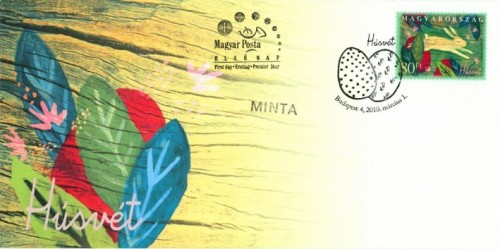
1. MAGYAR - HÚSVÉT 2010 - Bélyeg rendelési kód: F2010/005
2. ENGLISH - EASTER 2010 - Order code of the stamp: F2010/005
3. GERMAN - OSTERN 2010 - Die Bestellnummer Der Marke: F2010/005
1. MAGYAR - HÚSVÉT 2010
A húsvéti jókívánságok postára adásához ez évben is új forgalmi bélyeget bocsát ki a Magyar Posta.
A kereszténység egyik legnagyobb ünnepéhez, a Húsvéthoz népszokások, népi hagyományok és szimbólumok egyaránt kapcsolódnak. A húsvéti hímes, illetve piros tojás, a barka, a bárány, a nyúl, mind ennek az ünnepnek a jellemző és jól ismert jelképei, közülük néhány jelenik meg a 2010. évi húsvéti bélyegújdonságon.
A húsvéti nyúl eredetét illetően megoszlanak a vélemények. A nyúl és a tojás ősi kapcsolatát a kutatók egy része a germán hagyományok alvilági istennőjének legendájából eredezteti. Ez alapján a nyúl eredetileg madár volt, s az istennő haragjában négylábú állattá változtatta. Előfordulhat azonban az is, hogy tévedésről van szó, mert régen egyes német területeken húsvétkor szokás volt gyöngytyúkot tojásaival együtt ajándékozni.
A gyöngytyúk német neve Haselhuhn, röviden Hasel. A félreértés pedig abból adódhatott, hogy németül a nyúl neve Hase. Más források szerint a nyúl és a tojás a 16. századi Németországban vált a keresztény ünnepkör részévé, itt készítették ugyanis az első kosárfészket és később az első édességből készült nyulat is.
E teória szerint a fészekrakás valószínűleg abból vezethető le, hogy a nyugati kultúrákban ábrázolt nyúl általában a Lepus fajhoz tartozik, amely nem üregben él, hanem fészket rak, kicsinyei nyitott szemmel születnek, teste nagyobb és füle is hosszabb.
A magyar Nyúl községben a névazonosság külön ünneplésre ad alkalmat: húsvétkor hagyományosan két napig tartó rendezvénysorozatot szerveznek. Forrás: husvet.hu * hu.wikipedia.org * bdeg.sopron.hu
A bélyegképen a harsány tavaszi színekben pompázó grafikai kompozíció főmotívumai a húsvéti piros tojás és a nyuszi. Az alkalmi borítékon a bélyegkép grafikai elemei ismétlődnek. Az alkalmi bélyegző grafikája hímes tojásokat ábrázoló stilizált rajz.
Forrás: Magyar Posta
2. ENGLISH - EASTER 2010
This year Magyar Posta is once again issuing a new ordinary postage stamp to send Easter greetings.
Many folk customs, traditions and symbols are associated with one of Christianity’s most important festivals. Decorated and red eggs, catkins, the lamb and the bunny are typical and well-known symbols of this feast, and some of them appear on the new Easter stamp for 2010.
Opinions differ over the origin of the Easter bunny. Some researchers believe that the ancient connection between the bunny and eggs stems from the legend of the goddess of the underworld in German mythology, in which the bunny was originally a bird and the goddess turned it into a four-legged animal in her rage. However, it may be that the connection is based on a misunderstanding as in some German-speaking areas guineafowl with eggs used to be given as presents.
The German name for guineafowl is Haselhuhn or Hasel for short. The misunderstanding might have been caused by the German word for bunny, which is Hase. Other sources believe that the bunny and the egg became part of the Christian festivities in the German lands in the 16th century, where the first nest in a basket was made, and later the first confectionary bunny.
According to this theory, making a nest can probably be traced back to the fact that the bunny depicted in Western culture belongs to the Lepus genus, that is the hare, which does not dig a burrow but makes a simple nest. Its young are born with their eyes open, and they have bigger bodies and longer ears.
In Hungary there is a village called Nyúl (meaning bunny in Hungarian), and this gives locals a special reason to celebrate Easter with a series of events lasting two days. Source: husvet.hu * hu.wikipedia.org * bdeg.sopron.hu
The main subjects of the stamp design are red Easter eggs and the bunny, set in a rich composition with bright spring colours. The graphic elements of the stamp design are repeated on the first day cover. The design of the special postmark is a stylised drawing of decorated eggs.
3. GERMAN - OSTERN 2010
Die Magyar Posta gibt auch dieses Jahr eine neue Freimarke für die Aufgabe von Glückwünschen zu Ostern aus.
Mit Ostern, einem der größten Feste des Christentums sind Volksbräuche, volkstümliche Traditionen, ebenso, wie Symbole verknüpft. Die bunten bzw. roten Eier, die Weidenkätzchen, das Lamm, der Hase, all sie sind typische und wohl bekannte Symbole dieses Festes. Einige davon erscheinen auch auf der Briefmarkennovität Ostern 2010.
Zum Ursprung des Osterhasen gibt es verschiedene Erklärungsversuche. Ein Teil der Forscher leitet die ursprüngliche Verbindung zwischen dem Hasen und dem Ei von der Legende der unterweltlichen Göttin der germanischen Traditionen ab. Nach dieser Legende war der Hase ursprünglich ein Vogel, den die Göttin vor Zorn in ein vierbeiniges Tier verwandelte. Es kann aber auch sein, dass es sich hierbei um einen Irrtum handelt, denn früher war es in einigen deutschen Gebieten Sitte, Haselhühner samt ihren Eiern zu verschenken.
Zu Missverständnissen kam es vielleicht wegen des deutschen Namens Haselhuhn, kurz Hasel, was dem Wort Hase sehr ähnelt. Nach anderen Quellen wurden der Hase und das Ei im Deutschland des 16. Jahrhunderts zu Bestandteilen des christlichen Feierkreises, hier fertigte man nämlich das erste Osternest im Korb und später auch den ersten Osterhasen aus Zuckerwerk.
Nach dieser Theorie kann der Nestbau wahrscheinlich davon abgeleitet werden, dass der in den westlichen Kulturen dargestellte Hase im Allgemeinen zur Lepus-Art gehört, welcher nicht in Sassen lebt, sondern ein Nestbauer ist. Seine Jungen kommen mit offenen Augen zur Welt, sein Körper ist größer und auch seine Löffel sind länger.
In der ungarischen Gemeinde Nyúl (Hase) gibt besonders die Namensidentität Anlass zum Feiern. Ostern organisiert man hier traditionsgemäß eine zweitägige Veranstaltungsreihe. Quelle: husvet.hu * hu.wikipedia.org * bdeg.sopron.hu
Hauptmotive der in schrillen Frühlingsfarben prangenden grafischen Komposition auf dem Briefmarkenbild sind das rote Osterei und der Osterhase. Auf dem Sonderumschlag kehren die grafischen Elemente des Briefmarkenbildes wieder. Auf der Grafik des Sonderstempels ist die stilisierte Zeichnung bunter Eier zu sehen.










